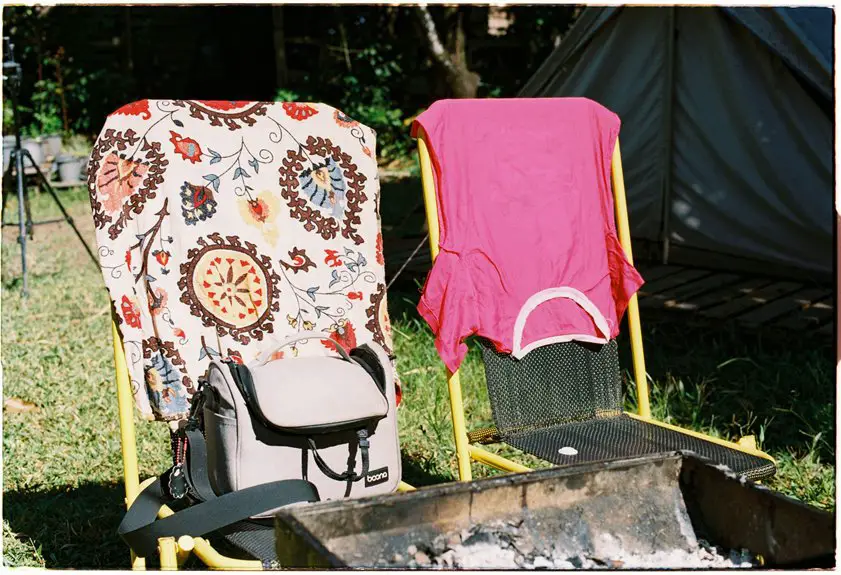To repair lawn chair fabric, first inspect for tears or holes and clean the area with mild soap and water, letting it dry completely. Use heavy-duty thread and a needle to sew small tears with a backstitch or apply fabric glue for quick fixes. For larger damage, iron on a matching patch firmly. Protect your chair by storing it in shade and checking repairs regularly. Keep going to discover tips on choosing the right patch and extending your chair’s fabric life.
Table of Contents
Key Takeaways
- Inspect fabric for tears, holes, or weak spots to determine if patching or full replacement is needed.
- Clean fabric with mild soap and water, then let it dry completely before starting repairs.
- Use heavy-duty needle and UV-resistant thread to sew small tears, employing backstitch or zigzag stitches for durability.
- Apply fabric patches with iron-on adhesive or fabric glue, ensuring proper alignment and firm pressure during application.
- Protect repaired fabric by storing chair in shade, using covers, and regularly applying fabric protectant spray.
Assessing the Damage on Your Lawn Chair Fabric
Before you begin repairing, take a close look at your lawn chair fabric to identify the extent of the damage. Check for tears, holes, fading, or fraying along the edges and seams.
Pinpoint whether the damage is isolated or widespread. Small punctures or rips can often be patched, while larger tears might require replacing the entire fabric piece.
Also, feel the fabric for any weak or thin spots that might soon give way. Don’t forget to examine where the fabric connects to the frame; sometimes damage starts there.
Check for weak spots and inspect connections to the frame, as damage often begins there.
Evaluating this carefully helps you decide the best repair approach and guarantees you don’t miss problems that could worsen later. Taking the time to assess now saves frustration and guarantees a longer-lasting fix.
Gathering the Necessary Tools and Materials
Once you’ve identified the damage on your lawn chair fabric, you’ll want to gather the right tools and materials to fix it properly.
Start with a heavy-duty needle and UV-resistant outdoor thread that matches your fabric color. You’ll also need fabric patches or replacement fabric if the tear is large.
Scissors are essential for trimming frayed edges and cutting patches to size. A seam ripper can help remove old stitching if necessary.
Keep fabric glue or adhesive tape on hand for quick fixes or reinforcing seams. Don’t forget a measuring tape to guarantee your patch fits perfectly.
Having all these tools ready will make your repair smoother and more effective, saving you time and effort when you start fixing your lawn chair fabric.
Cleaning the Fabric Before Repair
Although it might seem like a small step, cleaning your lawn chair fabric thoroughly is essential to guarantee your repair materials adhere properly.
Start by brushing off loose dirt and debris with a soft brush or cloth. Then, mix mild soap with warm water and gently scrub the fabric using a sponge or soft brush. Avoid harsh chemicals that could weaken the fabric fibers.
Rinse well with clean water to remove all soap residue, as leftover soap can interfere with adhesives or patches. Let the fabric dry completely in a shaded, well-ventilated area to prevent mold or mildew growth.
Taking these simple cleaning steps guarantees a strong bond during repair and extends the life of your lawn chair fabric.
Choosing the Right Patch Material
You’ll want to pick a patch material that’s as durable as the original fabric to guarantee it lasts.
Consider how the patch will blend with your chair’s seams for a smooth, secure fit. Choosing the right fabric and seam compatibility makes all the difference in a clean, strong repair.
Durable Fabric Options
When selecting a patch material, you want to focus on durability and weather resistance to confirm your repair lasts through sun, rain, and regular use.
Here are four durable fabric options to take into account:
- Outdoor canvas – Thick, tightly woven, and water-resistant, ideal for heavy-duty repairs.
- Vinyl-coated polyester – Offers excellent waterproofing and UV protection, perfect for all-weather chairs.
- Sunbrella fabric – Designed specifically for outdoor use, highly resistant to fading and mildew.
- Nylon ripstop – Lightweight yet strong, with reinforced weaving to prevent tears from spreading.
Choose one that matches your chair’s original fabric type and intended use to confirm a seamless, long-lasting fix.
Durable fabrics not only restore function but also maintain your lawn chair’s appearance.
Seam Compatibility Choices
Since your lawn chair fabric relies on seams to hold patches securely, you need to pick a patch material that matches or complements the original fabric’s seam structure. Choosing the right patch guarantees durability and prevents further damage. Consider the fabric type, thickness, and flexibility when selecting a patch. Here’s a quick guide to help you decide:
| Patch Material | Seam Type Compatibility | Best Use Case |
|---|---|---|
| Canvas | Flat-felled, Topstitched | Heavy-duty, outdoor |
| Polyester Mesh | Overlocked, Zigzag | Breathable, flexible |
| Vinyl | Heat-sealed, Welded | Waterproof, smooth |
| Nylon | Double-stitched, Lockstitch | Lightweight, strong |
| Denim | Flat-felled, Chainstitch | Casual, rugged look |
Match your patch material to the seam for a secure, long-lasting repair.
Techniques for Sewing Fabric Tears
When sewing fabric tears, you’ll want to pick stitch types that hold strong and blend well with the material.
Don’t forget to reinforce any weak spots around the tear to prevent it from spreading.
Using the right techniques will make your repair last longer and keep your chair looking sharp.
Choosing Stitch Types
Choosing the right stitch type plays an essential role in effectively repairing lawn chair fabric tears.
Different stitches provide various levels of strength and flexibility, so selecting one that suits your fabric and tear is key.
Here are four common stitch types to evaluate:
- Running Stitch – Simple and quick, ideal for small tears or temporary fixes.
- Backstitch – Strong and durable, perfect for seams that need to withstand tension.
- Zigzag Stitch – Offers flexibility and helps prevent fraying on fabric edges.
- Overcast Stitch – Wraps around the fabric edge to secure and protect from unraveling.
Reinforcing Weak Areas
Though small tears might seem manageable on their own, reinforcing weak areas guarantees your lawn chair fabric holds up longer under stress.
Start by trimming any loose threads around the tear to create a clean working surface. Then, use a patch of matching fabric slightly larger than the damaged spot. Position the patch on the underside of the fabric and pin it securely.
Sew around the tear with tight, even stitches, like a whipstitch or blanket stitch, to prevent further fraying. For extra durability, sew a second row of stitches around the patch’s edge.
This technique not only repairs the tear but also strengthens the surrounding fabric, helping your lawn chair withstand daily use without the damage worsening.
Using Fabric Glue for Quick Fixes
If you need a fast and reliable way to fix small tears or loose fabric on your lawn chair, fabric glue offers a convenient solution. It bonds quickly and keeps the fabric intact without sewing.
Here’s how to use it effectively:
- Clean the area around the tear to remove dirt and debris.
- Apply a thin layer of fabric glue along the edges of the tear.
- Press the fabric together firmly and hold it in place for a minute.
- Let the glue dry completely—usually a few hours—before using the chair again.
Fabric glue works best on minor damage and can extend your lawn chair’s life without complicated repairs.
Just remember to choose glue designed specifically for outdoor fabrics for the best hold.
Applying Iron-On Patches Properly
When you need a durable and neat repair for your lawn chair fabric, applying iron-on patches offers a strong, long-lasting solution.
First, clean and dry the damaged area thoroughly. Cut the patch slightly larger than the tear to guarantee full coverage.
Place the patch adhesive side down on the fabric, then cover it with a thin cloth to protect both surfaces. Heat your iron to the cotton setting without steam, and press firmly over the patch for 30-40 seconds.
Move the iron in small circles to guarantee even heat distribution. Let the patch cool completely before testing its hold.
Avoid shifting the patch during ironing to prevent wrinkles or bubbles. This method secures the fabric effectively, restoring your chair’s usability and appearance.
Maintaining Repaired Lawn Chair Fabric for Longevity
To keep your repaired lawn chair fabric in great shape, you need to care for it properly after fixing it.
First, avoid leaving your chair exposed to harsh weather; store it in a dry, shaded spot.
Store your repaired lawn chair in a dry, shaded area to protect it from harsh weather conditions.
Second, clean the fabric gently using mild soap and water to prevent damage to the patch.
Third, inspect the repair regularly for any signs of wear or loosening and reinforce it promptly if needed.
Fourth, apply a fabric protectant spray designed for outdoor materials to add an extra layer of defense against UV rays and moisture.
Frequently Asked Questions
Can I Use Outdoor Fabric Paint to Cover Patched Areas?
Imagine your lawn chair’s fabric as a canvas with a fresh patch. You can use outdoor fabric paint to blend colors seamlessly, giving it a vibrant, weatherproof finish that keeps your chair looking sharp and ready for sunny days.
How Do I Store Lawn Chairs to Prevent Fabric Damage?
You should store your lawn chairs in a cool, dry place away from direct sunlight. Use protective covers to prevent dirt and moisture buildup, and avoid stacking heavy items on them to keep the fabric from stretching or tearing.
Are There Waterproof Sprays Safe for Repaired Lawn Chair Fabric?
You’ll find waterproof sprays designed for outdoor fabrics that are safe for repaired lawn chair fabric. Just make sure to choose one labeled non-toxic and UV-resistant to protect and extend your chair’s life without causing damage.
Can I Replace the Entire Fabric on My Lawn Chair?
Just like a knight replacing his armor, you can totally swap out your lawn chair’s fabric. Grab new material, remove old strips, and secure carefully. It’s a satisfying DIY project you’ll enjoy tackling!
What Are Signs That the Chair Frame, Not Fabric, Needs Repair?
You’ll notice wobbling, bent or cracked metal, rust spots, or loose joints. If the chair feels unstable or creaks when you sit, the frame likely needs repair, not just the fabric. Check thoroughly.
- How to Use Scrim in Costume Design for Ethereal and Layered Effects - June 26, 2025
- How to Sew Scrim Fabric Without Snagging or Tearing - June 26, 2025
- A Beginner’s Guide: How to Rig and Light a Stage Scrim - June 26, 2025







